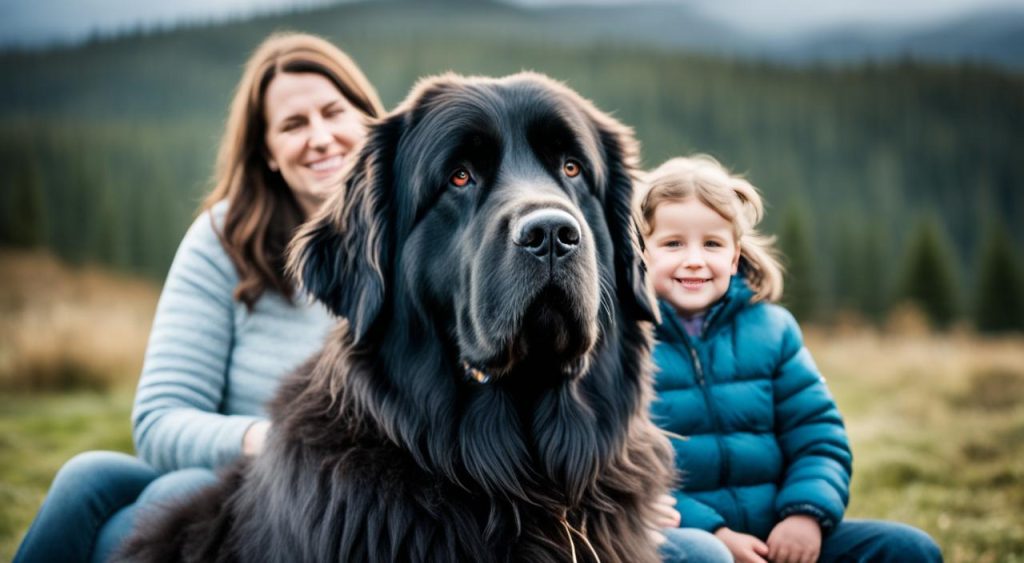Newfoundland dogs are beloved companions known for their gentle nature and impressive size. However, one aspect that potential owners should be aware of is their shedding. If you’re considering bringing a Newfoundland dog into your home, it’s important to understand their shedding patterns and learn how to manage excessive shedding effectively.
Newfoundland dogs have a double coat, consisting of guard hairs and a dense undercoat. This double coat helps protect them from the cold, particularly in their native Newfoundland, Canada. However, it also means that they shed regularly. Daily shedding is normal for Newfoundland dogs, but they tend to experience more significant shedding during the spring and fall seasons.
Contrary to popular belief, shedding in Newfoundland dogs is not solely influenced by temperature. Instead, it is influenced by their circadian rhythm, which leads to an increase in shedding during specific seasons. Managing this shedding requires dedicated effort.
Key Takeaways:
- Newfoundland dogs have a double coat consisting of guard hairs and a dense undercoat.
- They shed daily but experience more significant shedding during the spring and fall seasons.
- Shedding in Newfoundland dogs is influenced by their circadian rhythm, not just temperature.
- Regular grooming with appropriate tools is essential for managing shedding.
- Addressing excessive shedding can help keep your home fur-free.
When Do Newfoundland Dogs Shed the Most?
Newfoundland dogs are known for their luxurious double coat, which requires regular grooming to keep it in top condition. Understanding when these dogs shed the most can help you manage their excessive shedding and keep your home clean and fur-free.
Typically, Newfoundland dogs experience heavier shedding during the spring season. This shedding phase occurs as they shed their thick winter coat to prepare for warmer weather. The shedding is usually most intense for about 3-4 weeks, during which daily grooming is essential to prevent matting and remove tufts of undercoat.
During this shedding period, you may notice an increase in dog hair around your home, on your clothes, and in your car. However, with regular grooming and proper shedding management, you can significantly reduce the impact of shedding in Newfoundland dogs.
Factors That Influence Newfoundland Shedding
Several factors can influence the shedding patterns of Newfoundland dogs. The stage of life plays a role, with puppies shedding less until they develop their adult coat around 6-18 months. Senior dogs may shed more due to the aging process. Diet and exercise also impact shedding, with a balanced diet and regular exercise promoting healthier coats. Additionally, the presence of pests like ticks and fleas can cause excessive shedding.
Newfoundland Dog Grooming Needs
Newfoundland dogs have a unique coat that requires regular grooming to keep it healthy and manage shedding. Their double coat consists of a long, coarse outer coat and a soft, dense undercoat. To effectively groom your Newfoundland and minimize shedding, there are a few essential tips to keep in mind.
Brushing Techniques
Regular brushing is crucial for Newfoundland dogs to remove dead hair and prevent matting. A wire slicker brush is ideal for the outer coat, while an undercoat rake or comb is effective for the undercoat. Brush your Newfoundland a few times a week, or daily during shedding seasons, to keep the coat in top condition and reduce loose hair.
Other Grooming Needs
Grooming your Newfoundland goes beyond brushing. It’s essential to address their dental health by regularly cleaning their teeth using a dog-friendly toothbrush and toothpaste. Additionally, cleaning their ears and trimming their nails are important aspects of their grooming routine.
Bathing Frequency
Newfoundlands don’t require frequent bathing unless they become dirty or develop a strong odor. Over-bathing can strip their coat of essential oils and contribute to dryness and increased shedding. When bathing, use a gentle dog shampoo specifically formulated for their needs to maintain a healthy coat and skin.
By following these grooming tips and establishing a regular routine, you can effectively manage shedding in your Newfoundland dog and keep them looking and feeling their best.
Tips for Keeping Your Newfoundland Dog Healthy and Happy
Along with regular grooming, there are steps you can take to minimize shedding in Newfoundland dogs. Providing a balanced diet with omega-3 fatty acids can promote a healthy coat. Avoid over-bathing, as this can dry out their skin and increase shedding. Using natural shampoos designed for dogs is preferable. Adding a small amount of virgin coconut oil to their diet may also improve moisture in their skin and coat.
Are Newfoundlands Hypoallergenic?
Newfoundland dogs are not considered hypoallergenic. Their shedding and dander can trigger allergies in sensitive individuals. If you have allergies, it’s important to consider the potential impact of Newfoundland dog shedding before bringing one into your home.
Do Newfoundlands Smell?
Newfoundlands can develop a noticeable smell if not properly groomed and cleaned. Regular grooming and bathing are essential to prevent and manage Newfoundland dog odor. By following a proper grooming routine and using appropriate dog shampoos, you can help keep your Newfoundland smelling fresh and clean.
Paying special attention to areas like the ears and tail can minimize potential odor issues. Regularly checking and cleaning the ears, as well as keeping the tail area clean and dry, can help prevent any unpleasant smells from developing.
Alternative Breeds That Shed Less Fur
If shedding is a concern, there are alternatives to Newfoundland dogs that shed less fur. Crossbreeds like the Newfypoo (Newfoundland and Poodle mix) are known for their low shedding coats. Other large breeds with minimal shedding include the Irish Water Spaniel, Goldendoodle, Saluki, and Airedale Terrier.
The Origin and Traits of Newfoundland Dogs
Newfoundland dogs hold deep roots in the Canadian province of Newfoundland. These majestic canines have a remarkable blend of traits that make them beloved and cherished companions. Celebrated for their size, temperament, and loyalty, Newfoundland dogs have a fascinating history that traces back to their role as indispensable working partners to fishermen.
Originating from Newfoundland, these gentle giants were initially bred to assist fishermen in their maritime tasks. Their exceptional strength and intelligence made them perfect for retrieving nets, hauling wood, and even saving drowning individuals in rough waters.
Over time, their exceptional abilities and endearing nature captured the hearts of families, leading to an increase in their popularity as loyal and affectionate family pets. Today, Newfoundland dogs continue to serve as devoted companions, excelling not only within homes but also as remarkable water rescue dogs.
Newfoundland dogs are highly intelligent and possess an incredible level of strength. These traits, combined with their calm and gentle temperament, make them well-suited for various working purposes and as cherished family members.
It’s their distinctive blend of intelligence, strength, and gentle nature that sets Newfoundland dogs apart. They are known for their naturally calm demeanor, making them excellent companions for families with children. Their loyalty and protective instincts also make them highly reliable when it comes to safeguarding their loved ones.
When considering the traits of a Newfoundland dog, it’s important to recognize that their intelligent and strong-willed nature requires consistent training, socialization, and physical exercise to ensure a well-rounded and contented pet.
The Gentle Giant: Newfoundland Dog Characteristics
Newfoundland dogs are often referred to as “gentle giants” due to their impressive size and gentle nature. They can weigh up to 150 pounds and stand 28 inches tall.
They are known for their loyalty, intelligence, and affectionate demeanor. These dogs are incredibly loyal to their families and make excellent companions. Their intelligence allows them to learn quickly and adapt well to various situations.
Their calm and patient temperament makes them well-suited for families, including those with children. They are generally good with kids and can be gentle and tolerant with them.
Being social and friendly, Newfoundland dogs also tend to get along well with other pets, especially when properly socialized. They have a peaceful and harmonious nature, which contributes to their ability to coexist peacefully with different animals.
“Newfoundlands are known for their loyalty, intelligence, and affectionate demeanor.”
However, it’s important to consider their size when interacting with smaller children or pets to prevent any accidental injuries. Supervision and proper training are essential to ensure everyone’s safety and well-being.
The Importance of Regular Newfoundland Dog Grooming
Grooming is an essential part of caring for your Newfoundland dog, especially due to their thick, double coat. Regular grooming not only keeps your dog looking neat and tidy but also offers several benefits for their overall health and well-being.
Grooming helps remove dead hair, which can otherwise accumulate in your home. By brushing your Newfoundland regularly, you can significantly reduce the amount of loose hair that ends up on your furniture, clothing, and floors.
Additionally, grooming helps prevent matting, which is when the hair becomes tangled and knotted. Mats can be uncomfortable for your dog and can also trap moisture, leading to skin issues. Regular brushing keeps the coat smooth and prevents mat formation.
Furthermore, grooming provides an opportunity to inspect your Newfoundland’s skin for any signs of irritation, allergies, or pests like ticks and fleas. Early detection of these issues allows for prompt treatment, ensuring your dog’s comfort and preventing more serious health problems.
To establish a grooming routine for your Newfoundland, start early with gentle brushing sessions and gradually increase the length and frequency as your dog becomes more comfortable. Consistency is key, as regular grooming helps maintain the optimal condition of your dog’s coat.
Remember to use appropriate grooming tools for your Newfoundland’s coat, such as a wire slicker brush for the outer coat and an undercoat rake or comb for the dense undercoat. This will help you effectively remove dead hair and keep the coat in top shape.
In summary, regular grooming is vital for Newfoundland dogs to maintain a healthy coat, prevent matting, and ensure overall well-being. By incorporating grooming into your routine and providing your dog with the care they need, you can enjoy all the wonderful benefits that come with having a happy and well-groomed Newfoundland.
Why Newfoundlands Make Great Family Companions
Newfoundland dogs are the perfect addition to any family. Their loyalty and love for their families make them excellent family companions, ensuring a deep bond with each family member. They are gentle and patient with children, making them ideal playmates and protectors.
“Newfoundlands have a calm temperament, which allows them to be patient and understanding with children of all ages,” says Dr. Sarah Thompson, a veterinarian specializing in canine behavior. “Their size and strength also make them natural protectors, giving parents peace of mind.”
Not only are they great with children, but Newfoundland dogs also get along well with other pets. Whether it’s a cat, another dog, or a small furry friend, Newfoundlands are known for their friendly and accepting nature.
“Newfoundlands have a natural affinity for other animals,” says Amy Johnson, a certified dog trainer. “They are gentle giants and often become best friends with other pets in the family, creating a harmonious and loving environment.”
So, whether you have a bustling household with children and multiple pets or you’re a smaller family with one furry friend, a Newfoundland dog will fit right in. Their calm temperament, protective nature, and unwavering loyalty truly make them the perfect family companions.
Conclusion
Newfoundland dogs are beautiful and loving companions that bring joy to families. However, it is important to note that they require regular grooming to manage their shedding. Understanding their shedding patterns and implementing a grooming routine will help minimize the impact of shedding and keep your home fur-free.
By brushing their thick double coat a few times a week, especially during shedding seasons, you can remove dead hair and prevent matting. Using the right grooming tools, such as a wire slicker brush and an undercoat rake, will effectively remove loose hair without causing discomfort to your Newfoundland dog.
Promoting a healthy coat in your Newfoundland dog involves providing a balanced diet rich in omega-3 fatty acids. Avoid over-bathing, as this can dry out their skin and lead to increased shedding. Instead, opt for natural shampoos designed for dogs and consider adding a small amount of virgin coconut oil to their diet to improve the moisture of their skin and coat.
Before bringing a Newfoundland dog into your family, carefully consider if their shedding and grooming needs align with your lifestyle. By providing the necessary care and attention, you can ensure that your Newfoundland dog remains healthy, happy, and a cherished member of your family.



